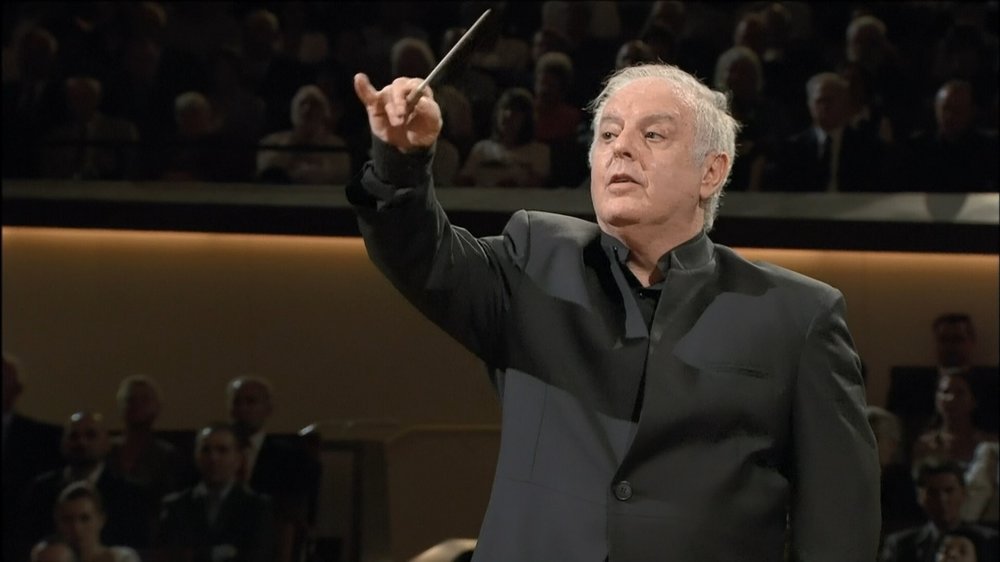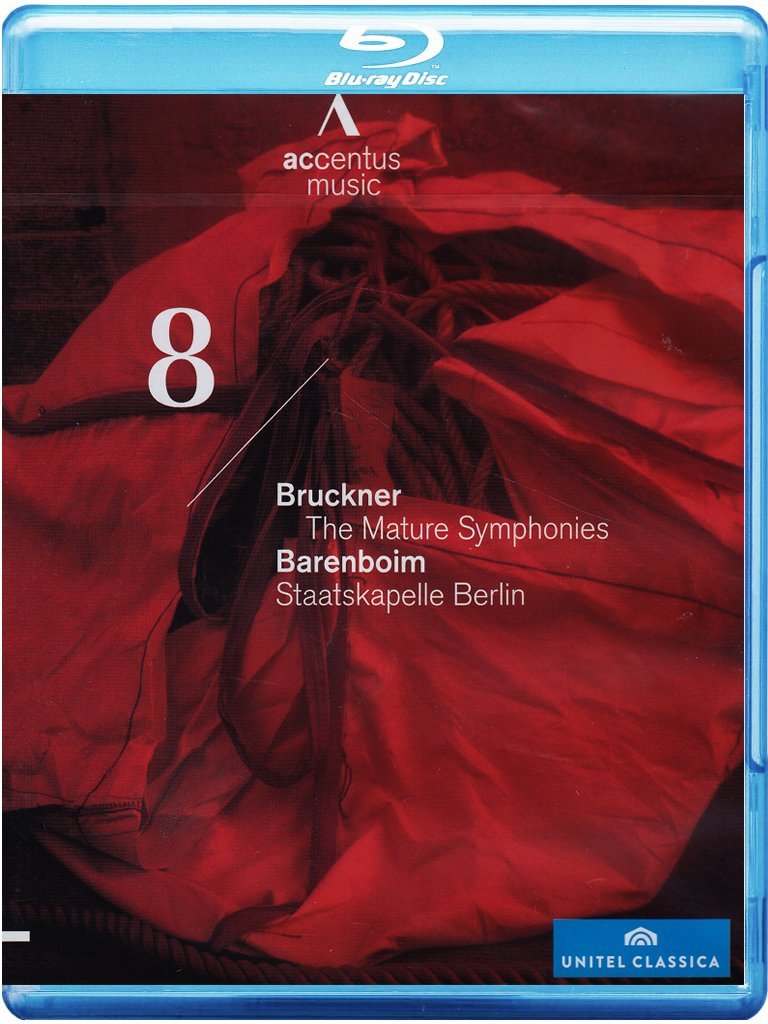Bruckner Symphony No. 8 concert (Edition: Robert Haas). Daniel Barenboim conducts the Staatskapelle Berlin at the Philharmonie Berlin in 2010. This is part of the "Bruckner Mature Symphonies" series by Accentus. Directed for TV by Andreas Morell; produced by Paul Smaczny. Released 2014, disc has 5.1 dts-HD Master Audio sound. Grade: C+
This review was contributed by Work Bryan Balmer. Thank you again Bryan!

This is a most enjoyable performance of Bruckner’s Symphony No. 8, and a very fine DVD filming. Yes . . . I said “DVD” despite the fact that I own this title on Blu-ray and wrote this review after watching it in HD. Subject title is infected with DVDitis. It's yet another proof of the maxim that a great DVD can't be a great HDVD and a great HDVD can't be a great DVD. For more on all this, see our special articles on (1) what makes for a good symphony HDVD, (2) our Wonk Worksheet, and (3) the Wonk Worksheet Instructions. Now having given proper warning, I still suspect many readers could find much to enjoy here.
Barenboim and the Staatskapelle Berlin are both in absolute top form. Their long-standing relationship appears to have reaped many rewards, with his directorship dating back to 1992. As a sign of the strength of their relationship, he was voted by the orchestra to “chief-conductor-for-life” in 2010. I was so taken by the rich and blended sound of the orchestra, that it prompted me to undertake an internet search for “World’s Best Orchestra.” As it turned out, the Berlin Staatskapelle didn’t make Gramophone’s “top 20” list in 2015; however, I found a more obscure critic’s survey from around the same time period that placed them in the top 10.
The work itself is a monumental one—lots of emotion, and lots of “Wow” moments too! When filling in my Wonk Worksheet, I jotted down 18 specific track timings in the “Performance Notes” section with comments like: "Magical”, “Took breath away”, “Haunting, beautiful, intense”, “Blazing!”, “Brass!”, and “Great rhythm.” The audio is very transparent and has good presence. Picture quality is very sharp. This would be expected from videographer Andreas Morell, who has been dubbed on this website as the "best in the business at making video of the human body in motion." There are some instances where focus in an image is less than uniform (i.e. depth of field). But with Morell on the job, but I thought this may have been more of an artistic choice than a technical shortcoming.
The following are the statistics for this title, obtained using a Wonk Worksheet (see the Wonk Worksheet Instructions for explanation of the abbreviations):
Conductor = 105
C/B = 33
Solos, S§, SG, & misc. small-scale = 332
*L§, LG, & misc. large-scale = 48
*PO = 27
*WO = 1
IO = 24
Other low value = 19 (“anthill” shots)
There's a total of 589 clips over 78 minutes of music, which yields a pace of 8.0 seconds per clip. Supershots (those marked * above) amount to only 13% of the total clips, while the 138 conductor shots come in at 23% of the total.
We have established the following rules-of-thumb to identify a Blu-ray with DVDitis:
A good symphony HDVD should have a slow pace with more than 10 seconds per video clip on average (the longer the better). 20 to 40% of the clips should be large-scale "supershots." Conductor shots should be less than 20% of the clips in the video (way less really).
This video fails on all 3 tests, and therefore has a severe case of DVDitis. Let’s look at screen shots before formulating our final grade.
I classified only 1 clip in the entire title as a whole-orchestra (WO) shot. This sole WO shot is seen in the first screenshot below. It lasted for only 5 seconds, and appeared in the final 2 minutes of the work. One obligation of the videographer of a symphony is to show WO shots early to help the viewer get oriented to the layout of the orchestra. In this regard, Morell's video is utterly deficient:
The remaining clips in which the entire orchestra was visible were all “anthill” shots—19 in total. Next below is one of these anthills:
The two screenshots immediately above illustrate well the reason why a DVD can't become a good HDVD and a good HDVD can't be a good DVD. The resolution of DVD images in a TV display is too weak to show an entire symphony orchestra in one frame. The image would be too fuzzy for the viewer at home to tolerate. Morell covers for this by showing 19 brief shots of the building. The audience is impressed and fails to notice that the musicians look like a bunch of squirming ants and the only instruments you can detect are the double-basses and the tympani (don't try to count the double-basses). Now turn things around. If you made a symphony video for Blu-ray (or HDVD) with lots of whole-orchestra and other large-scale shots and then published that in a DVD, the customer would quickly realise that he couldn't see much clearly and would return the disc as defective.
Despite the lack of WO shots, there were some nice PO shots like the 3 screenshots next below:
There are also some nice large-scale shots in subject title. The angle of the first large-scale shot below isn’t ideal, but the next two shots are of high quality:
Earlier I commented that this was a finely-filmed DVD. The star shots in this title are definitely the smaller-scale ones (that can look good both in DVD and in HDVD). Morell captured some exceptional moments in close-up . . . including many shots highlighting the exquisite symmetry of motion that can occur in a symphony orchestra. Enjoy!
3 sets of harpist’s hands, very well synchronized:
Smiles in the audience after a cymbal crash:
Time for a grade. We starting with A+. Now compare the screenshots you see here to those in the review of Bruckner Symphony No. 8 by the Cleveland Orchestra under Welser-Möst. This will help you see why we must deduct 3 full grades here in view of the fact that subject title flunked all 3 of our tests for a proper symphony title. This brings us to a D+.
Still, you can tell I like this title. I believe that I can get away, thanks to the exciting performance and fine small-scale filming my Morell, with nudging this up by a grade to C+. It's just too bad the producers didn't budget to let Morell make a batch of large-scale shots to use solely in the HDVD disc. Then there could have been different videos for the DVD and the HDVD—with each likely worthy of an A grade.
OR


















